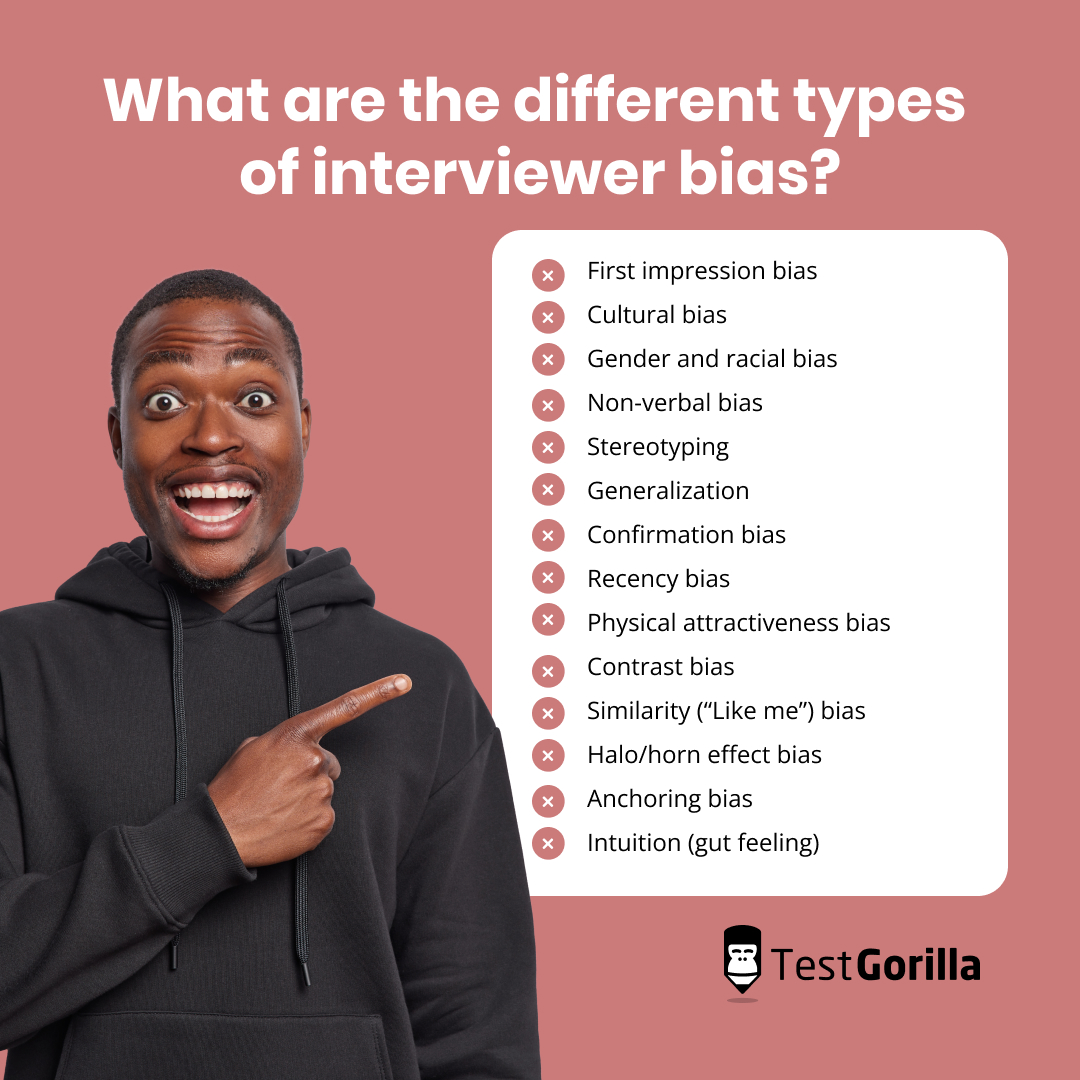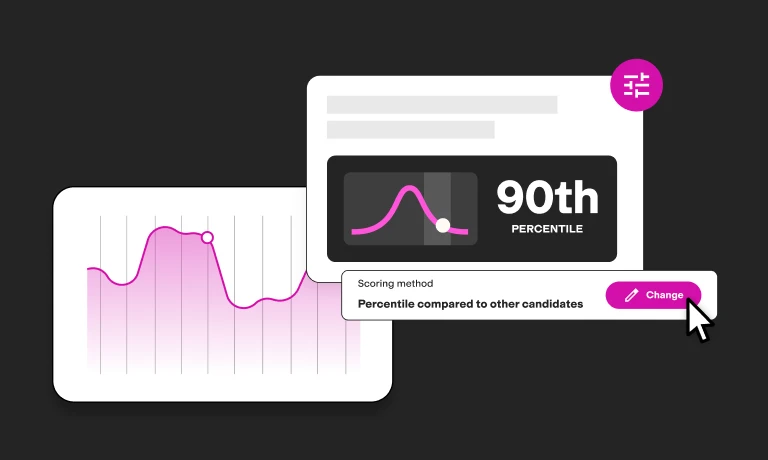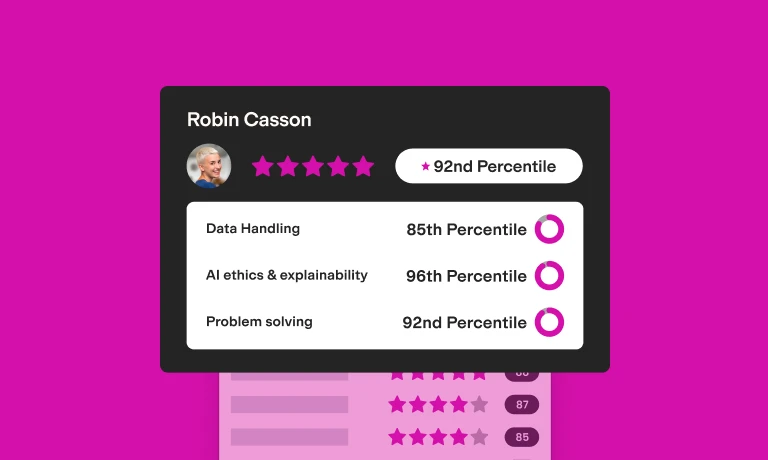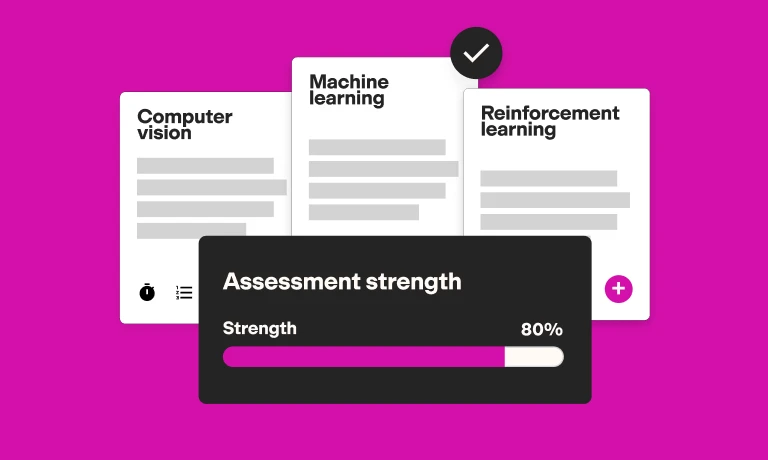Interviewer bias in recruiting: Types and how to avoid it
Humans are hardwired to evaluate social situations quickly and make instant decisions based on preconceived notions. Sometimes this can happen before you even interact with the other person.
For example, as a recruiter, you might have a positive bias for a particular male candidate because you also identify as male. Or a particular candidate went to the same university as you or wore your favorite color. Perhaps you might see someone as less skilled because of their accent or a 1-year career break they took. It's worth noting that none of those things are related to their skills.
Deciding who to hire based on your first impressions and unconscious bias is counterproductive. This can skew the hiring process and result in bad hires, and cost your company time, money, and talent.
Keep reading to learn about interviewer bias, its types, and how to avoid it in your employee selection process.
What exactly is interviewer bias?
Interviewer bias, also known as interview bias or hiring bias, is a type of unconscious bias that clouds your ability to evaluate applicants during the hiring process objectively.
Biases are directly related to intuition and feelings, rather than to reason and logic, according to Daniel Kahneman, Nobel laureate in Economics. The two modes of thinking (intuition vs. reason) govern our decision-making process, but our intuitive reactions can—and often do—override analytical thinking. While interviewing candidates, hiring managers are susceptible to interview bias, especially if they don’t make a conscious effort to limit their influence.
So, what are the different types of biases? And how do you make sure you’re not letting your biases get in the way of finding the most qualified candidate?
Let’s look into the details.
What are the different types of interviewer bias?
Many types of biases could influence the hiring process—and hiring managers aren’t immune to them.
1. First impression bias
First impression bias is related to how a candidate presents themselves and behaves in the first few minutes of an interview. It’s one of the primary reasons behind a bad hiring decision. When you initially like someone, you tend to ask easier questions and look for things that confirm your positive impression.
2. Cultural bias
It’s natural to feel more at ease with someone who shares the same culture as you. Cultural differences exist in how we express our emotions, too.
According to a 2019 study by Lucy Zhang Bencharit., the way candidates share their excitement has a profound impact on hiring managers’ decisions. Candidates who shared a similar cultural background with the recruiters—and expressed emotions similarly to them—were hired more often. Foreign accent bias is also a form of cultural bias.
3. Gender and racial bias
Although companies with a diverse workforce are between 15% and 35% more likely to perform well in a given financial year, gender and racial bias are, unfortunately, still very present, both in the US and worldwide.
The good news is that companies that do skill tests have the ability to hire a more diverse workforce. This approach ensures that a male or female candidate regardless of race are evaluated fairly based on their merits, fostering a more inclusive and diverse workforce.
Recommended reading: The ultimate guide to diversity and inclusion hiring for HR teams
4. Nonverbal bias
Nonverbal bias is related to how you perceive candidates’ body language, the way they dress, and diverse non-verbal cues. These can include their ability to maintain eye contact, the strength of their handshake, or their posture, among others. For example, you might feel that a weak handshake is a red flag, but in fact, it doesn’t relate to a candidate's qualifications, knowledge, and experience.
5. Stereotyping bias
Stereotype bias is the assumption that someone will perform in a specific way in a job because they belong to a given group. Stereotypes can be related to the candidate’s nationality, ethnicity, gender, age, among other characteristics. For example, you could assume that a 50-year old system administrator is not knowledgeable of the latest DevOps trends, but their age has, in fact, nothing to do with their DevOps skills.
6. Generalization
Generalization bias occurs when you believe that what the candidate did once would be what they always do in a similar situation. This type of bias can significantly impact hiring decisions by placing undue negative emphasis on a candidate's responses and behaviors. For example, if they were nervous during the interview, you might assume they’re always nervous.
7. Confirmation bias
When you have a well-defined first impression of someone, confirmation bias will push you to look for things that confirm your initial impression or preconceived ideas—and ignore the signs that disprove it.
8. Recency bias
Recency bias means remembering your last candidates better while not recalling the first interviews you did for a given position. This could mean that the last person you see might feel like the best candidate for the job—simply because you remember them better. Address this type of bias by reviewing detailed notes after the interview to help you judge a candidate's suitability more objectively.
9. Physical attractiveness bias
The bias related to the perceived physical attractiveness of candidates is most often unconscious—but might be particularly strong. A study by Christian Pfeifer, on physical attractiveness, employment, and earnings, concluded that people who are perceived as more attractive are hired more often and earn better wages. According to his data, differences were significant.
10. Contrast effect bias
Contrast effect bias means that you’re prone to comparing the last candidate to the one you interviewed before that. You anchor their performance and your expectations to the performance of another interviewee, which means that your judgment is not neutral. If the previous candidate did poorly, the next one might seem a much better fit—even if they’re not actually qualified for the role.
11. Similarity bias
Similar bias, also known as affinity bias, happens when an applicant is similar to you in some way, this might make you feel like they’d be a good fit for the position—even if they don’t meet some of your key criteria. Be wary of giving preference to candidates simply because they display similar traits are you, share your interests or opinions, or because you could imagine getting along well with them.
12. Halo/horn effect bias
A halo/horn effect bias occurs when you focus too heavily on a given positive or negative characteristic of the candidate and ignore the rest. The trait you’re fixating on can overshadow the rest and cloud your judgment. This happens, for example, if a candidate looks relaxed and confident during the interview, or is generally likable, making you assume they have the necessary skills for the position.
13. Anchoring bias
If the hiring manager has a pre-set idea on what the perfect candidate should be like, they’ll anchor applicants’ performance on that specific ideal. Anchoring and the horn/halo effect are quite similar: they let a specific trait, skill, or experience of the candidate define your decision.
14. Cultural noise bias
Cultural noise bias happens when a candidate provides socially acceptable or politically correct responses that they believe will align with the interviewer's expectations or preferences rather than giving genuine or authentic answers. For example, a candidate who prefers to be an individual contributor may tell you, as the hiring manager, that they always like working with big teams.
15. Intuition or gut feeling bias
We hear all the time that we should trust our instincts. In the context of hiring, however, gut feeling is actually simply an expression of our own unconscious biases, and shouldn’t be the reason that motivates your hiring choices.
The best insights on HR and recruitment, delivered to your inbox.
Biweekly updates. No spam. Unsubscribe any time.
What can you do to eliminate bias in the interview process?
Now that you already know the different types of bias during the interview stage of potential candidates, let's move on to the different ways to reduce bias.
1. Be self-aware
A heightened sense of self-awareness and your potential discriminatory bias goes a long way in keeping an impartial and open mind. Question your decisions and take detailed notes to make your decision-making process more transparent and clear.
Remember that there are many different types of biases you can fall prey to, and although you might be conscious of some of them, this usually isn’t sufficient to eliminate them, which brings us to the tips below.
2. Write a clear and well-defined job description
Define the job requirements and the necessary skills and be as precise as possible. If you’re vague—both internally, when discussing the job opening, and externally, in your job ad—this leaves plenty of space for your own biases to skew the interviewing process.
Being clear and specific projects a positive company image to prospective candidates, too, which is essential if you want to attract the right candidate who will do the job satisfactorily.
Be realistic in your requirements, though—do not write the job ad with an ideal person in mind, for example, the person leaving the company and whose position you want to fill. This way, you might be anchoring your expectations to their performance and background and not allow for neutrality in your hiring process.
It’s equally important to leave out stereotypically gendered words or requirements in your job ad to attract a more diverse candidate pool and hire the right person.
Learn more: How to prepare job descriptions for a skills-based hiring approach
3. Anonymize resumes and create a few different categories
Anonymizing resumes can help you eliminate bias associated with the name, gender, age, and location of candidates. This is particularly helpful if a part of your hiring process is automated.
Alternatively, you can create a few different categories to select candidates. Research shows that grouping resumes together (e.g., by candidates’ university) increases selection diversity, without lowering its quality. This happens because hiring managers tend to pick job candidates from each category and still pick the strongest ones. It's worth noting that this approach is only likely to work when managers don't have strong biases against a particular group.
4. Automate a part of the hiring process and test candidates’ skills
Another way to minimize bias during a job interview is to automate a part of the recruitment process. This can be done by administering pre-selection skills tests.When assessed objectively, this type of tests help recruiters choose candidates based on their skills & knowledge.
Skill tests are very flexible and can be used for many different skills:language proficiency, technical, and cognitive skills alike. For example, you can test for critical thinking, attention to detail, or also for SEO copywriting, complex queries in SQL, or intermediate French. You can even test for culture fit.
You could administer a few tests for a given position, and easily compare results afterward. This allows you to select candidates based on merit, and minimize unconscious bias. You can also anonymize test results too to be more neutral when interpreting the results.
Quick tip: If you’re asking candidates to take a few tests, make sure you’re not overwhelming them with a lengthy and overly complicated selection process.
5. Screen candidates on the phone
Screening calls can help you eliminate some of your biases. During a call, you don’t get all the non-verbal cues you have in a live or video interview. As you don’t get to see the person, you don’t risk to be influenced by their physical appearance, style, or clothing choices. Structure your interviews and take notes to make the most out of each call.
Phone screening interviews are usually short, but unforeseen interruptions can still happen. Don’t make biased conclusions on the candidate’s preparedness based on that.
6. Do structured interviews
Structured interviews can be particularly helpful if you want to have a neutral, non-biased hiring process. When doing structured interviews, the recruiting manager systematically asks all candidates the same questions, in the same or similar order. This leaves little place for small talk or subjectivity and allows them to compare applicants based on objective criteria.
In fact, small talk is highly irrelevant to the candidate’s skills and might cloud your judgment, for example, because of common interests (or the lack of such). Structured interviews standardize the hiring process, and give an equal opportunity to each candidate to demonstrate their skills and knowledge.
Structured interviews are good predictors even for positions where the nature of the work itself is unstructured. That’s also why Google uses them, in combination with behavioral and cognitive assessments, among others.
Recommended reading: Conduct a structured interview with this interview guide template
8. Have multiple interviewers conduct interviews
Organizations can employ multiple interviewers to ensure equal assessment and reduce interview bias. This method involves a panel of interviewers with varied perspectives who collectively judge candidates' responses. This method promotes fairness and minimizes individual biases for a more objective evaluation of potential employee performance.
9. Cast a wider net and recruit broadly
You can increase the likelihood of attracting a diverse pool of applicants by casting a wide net and actively seeking candidates from diverse backgrounds and sources.
Recruiting from multiple sources helps reduce bias in hiring and leads to a more diverse workforce. Utilizing various recruitment channels like job boards, social media, professional networks, and partnerships with diverse organizations also expands the candidate pool.
10. Document the hiring process
For each interview and phone call take detailed notes. Do not rely on your memory, which is far from perfect, especially if you need to do a lot of interviews in a short period of time. Instead, take structured notes, so that you can easily compare them afterward. You can also use hiring scorecards or an assessment matrix to note of applicants’ performance and systematize your observations.
Each decision that you make during the hiring process also needs to be documented and added to the candidate’s file. Performance predictions can help you improve your interviewing process over time, as you compare them with your chosen candidates’ actual performance.
Your next step in neutralizing interview bias in recruiting
Organizations need to adopt a multi-faceted approach to avoid interview bias in hiring.
Writing clear job descriptions and implementing structured interview methods helps standardize the evaluation process, ensuring consistent criteria for all candidates.
Providing interviewers with training on unconscious bias and diversity awareness equips them to be more objective and fair judges. Using an interview guide like a scorecard or matrix with predetermined questions and evaluation criteria further minimizes subjectivity.
Finally, interviewers may focus on the qualifications and skills of the candidate based on objective evidence rather than personal impressions or assumptions. This is what skills testing by TestGorilla is about. Get started with a free account today.
Related posts
You've scrolled this far
Why not try TestGorilla for free, and see what happens when you put skills first.















